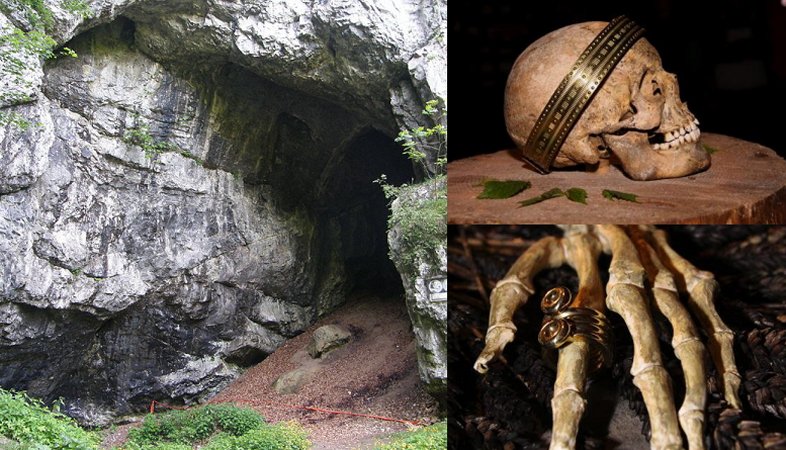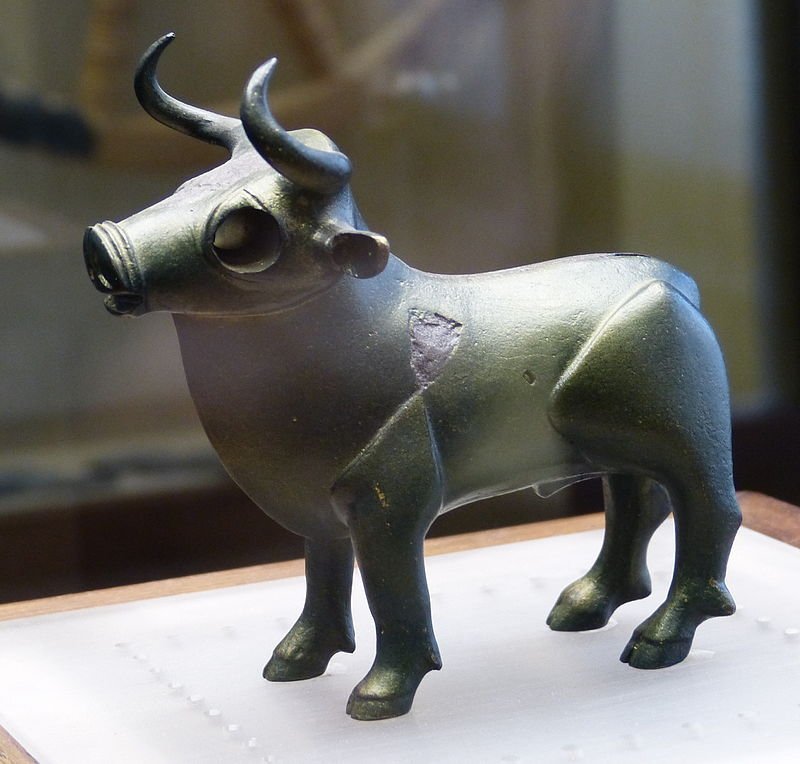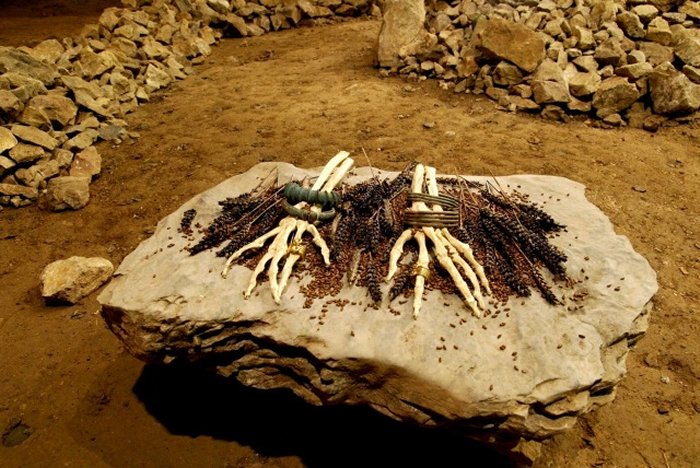Puzzle Of The Bull Rock Cave – Ancient Mass Grave Remains Unexplained
Ellen Lloyd - AncientPages.com - The Bull Rock Cave in Moravia, Czech Republic, is one of Europe's most amazing archaeological sites. The cave has long been known to the locals, but this ancient site was never properly examined.
Recent investigations reveal this mysterious place has a dark history. It was a site where gruesome events occurred, and archaeologists are still uncertain why certain remarkable artifacts and skeletons were hidden in the Bull Rock Cave.
Many traces lead to the Celts, who played a very important role in the history of ancient Europe. However, many of the unearthed artifacts also reveal the presence of people from different parts of the world. The discovery of an ancient mass grave at the site still remains unexplained.
Left: Entrance to the Bull Rock Cave, Credit: Wikipedia - Right-top: 2,600-year-old skull found in the cave, Credit: Prague Post - Right-bottom: Finger-ring, Credit: Prague Post
The Bull Rock Cave (Býcí skála Cave) has been home to many people during different epochs. Modern archaeologists have established that the Bull Rock Cave was occupied during the Palaeolithic, Eneolithic, Hallstatt, La Têne, and Medieval periods, but only for short periods.
Between 1867-1873, archaeologist Jindřich Wankel examined the cave and found evidence of a Palaeolithic settlement from around 100,000 - 10,000 B.C.
Famous Hallstatt culture bronze statue of a bull found in the Bull Rock cave. Credit: Wikipedia
In 1872, Wankel announced an incredible archaeological discovery. Two young boys had found a bronze Celtic bull statue dated to ca. 560 B.C. Wankel and his scientists also found animal and material offerings, crops, textiles, ceramic and sheet-metal vessels, jewelry, glass, and amber beads inside the Bull Rock Cave.
Gruesome Discovery Inside The Bull Rock Cave
The next discovery was less pleasant. Wankel said skeletons of one man and forty young women were unearthed inside the cave. Some women were beheaded, and some were missing legs or hands. One of the skulls had been placed in a bucket. On a small stone altar adorned with stalks of grain lay two arms with bracelets and gold rings, next to which was a skull that was spliced in half.
On a small altar, severed hands were placed. Credit: Balkan Celts
Deeper inside the cave, archaeologists found remains of a chariot with bronze fittings and the skeleton of a man. At the cave entrance was a Celtic Iron Age metal workshop and tools.
Who were these people, and why had they died inside the Bull Rock Cave? Wankel thought that he had discovered a Celtic chieftain’s burial. He assumed that all the artifacts had been offerings and the horse and young women had been sacrificed.
Will Scientists Finally Unravel The Secrets Of The Bull Rock Cave?
Later investigations revealed Wankel’s theory was not entirely correct. Researchers determined that not all of the skeletons belonged to women. Most of the victims were male and women between 30-60 years old. The remains of children were also identified. It was also unclear whether the victims had been sacrificed or murdered. Many of the artifacts discovered at the site come from all over Europe. Researchers found amber from the Baltic, bronze belts typical of northern Italy, and iron weapons from the Caucasus. This is a problem because archaeologists do not know the people's identities in the cave.
There are many theories attempting to explain what happened at the site. Some suggest the Bull Rock Cave was home to an ancient cult and a place of sacrifice. Others have put forward theories promoting ancestral warfare, the extermination of a cult site, or the assassination and slaughter of merchants. All of these theories remain speculative until new evidence is found.
Currently, the Bull Rock Cave still remains an unsolved ancient European mystery.
It should also not be forgotten that the cave contains a Neolithic picture. It is the oldest cave painting known in the Czech Republic. It depicts a geometrical shape resembling a grill with a size of 30x40 cm, painted in charcoal on the cave wall.
During World War II, the Nazis built an underground factory in the cave, damaging the entrance area. After the war, a few more caves were discovered. Further excavations of the cave can shed more light on the history of this place.
Exploring the mysterious cave on your own is not allowed. Except for the entrance, the cave is not accessible to the public, although occasionally, it is open to visitors. Several of the artifacts discovered in the Bull Rock Cave are stored in the Natural History in Vienna, Austria.
There are many interesting caves in Europe. Another place of great interest is the Ciemna Cave which we discussed earlier on Ancient Pages. The Ciemna Cave in Poland was inhabited by humans as far back as 120,000 years ago.
Updated on January 4, 2023
Written by - Ellen Lloyd AncientPages.com
Copyright © AncientPages.com All rights reserved. This material may not be published, broadcast, rewritten or redistributed in whole or part without the express written permission of AncientPages.com
Expand for referencesMore From Ancient Pages
-
 Hidden Geometric Patterns Found At Göbeklitepe – The Site Of World’s First Temple
Archaeology | May 1, 2020
Hidden Geometric Patterns Found At Göbeklitepe – The Site Of World’s First Temple
Archaeology | May 1, 2020 -
 Strangest Maps Ever Created – You Have Never Seen Our World Like This!
Featured Stories | May 18, 2022
Strangest Maps Ever Created – You Have Never Seen Our World Like This!
Featured Stories | May 18, 2022 -
 Challenging Prehistoric Gender Roles – Women Were Hunters Too – Not Just Men
Archaeology | Oct 21, 2023
Challenging Prehistoric Gender Roles – Women Were Hunters Too – Not Just Men
Archaeology | Oct 21, 2023 -
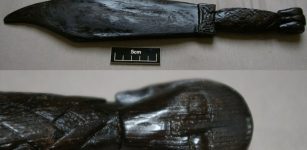 1,000-Year-Old Viking Weaver’s Sword Reveals Its Secrets
Archaeology | Apr 17, 2022
1,000-Year-Old Viking Weaver’s Sword Reveals Its Secrets
Archaeology | Apr 17, 2022 -
 Melisandre, The Red Woman: The History Behind Game Of Thrones’ Mysterious Mystic
Featured Stories | Jun 19, 2019
Melisandre, The Red Woman: The History Behind Game Of Thrones’ Mysterious Mystic
Featured Stories | Jun 19, 2019 -
 Mysteries Of The Huldufolk – The Hidden People Of Iceland
Featured Stories | Feb 1, 2022
Mysteries Of The Huldufolk – The Hidden People Of Iceland
Featured Stories | Feb 1, 2022 -
 Unique Structure ‘Wooden Version Of Stonehenge’ – Identified In The Perdigões Complex, Portugal
Archaeology | Aug 6, 2020
Unique Structure ‘Wooden Version Of Stonehenge’ – Identified In The Perdigões Complex, Portugal
Archaeology | Aug 6, 2020 -
 Ancient Mesopotamian City Discovered And Identified As Xarab-i Kilashin
Archaeology | Jul 11, 2017
Ancient Mesopotamian City Discovered And Identified As Xarab-i Kilashin
Archaeology | Jul 11, 2017 -
 Search For Noah’s Ark Continues – The ‘Inside Mount Ararat’ Research Project
Featured Stories | May 4, 2014
Search For Noah’s Ark Continues – The ‘Inside Mount Ararat’ Research Project
Featured Stories | May 4, 2014 -
 Mystery Of Hizir – One Of The Most Enigmatic And Extraordinary Ancient People
Ancient Mysteries | Oct 16, 2018
Mystery Of Hizir – One Of The Most Enigmatic And Extraordinary Ancient People
Ancient Mysteries | Oct 16, 2018 -
 Solar Eclipses And New Attempt To Date Homer’s Iliad And Odyssey
Myths & Legends | Jan 7, 2016
Solar Eclipses And New Attempt To Date Homer’s Iliad And Odyssey
Myths & Legends | Jan 7, 2016 -
 Secret Hidden Freemasonic Messages Concealed In Ancient Egyptian Artifacts And Roman Works – Curious Stellar Symbol – Part 2
Ancient Mysteries | Feb 23, 2022
Secret Hidden Freemasonic Messages Concealed In Ancient Egyptian Artifacts And Roman Works – Curious Stellar Symbol – Part 2
Ancient Mysteries | Feb 23, 2022 -
 Sword-Kladenets – Hidden Treasure Awaiting A Worthy Hero
Featured Stories | Feb 15, 2021
Sword-Kladenets – Hidden Treasure Awaiting A Worthy Hero
Featured Stories | Feb 15, 2021 -
 Mystery Of Charterhouse Warren’s Early Bronze Age Site Solved By Scientists
Archaeology | Dec 27, 2024
Mystery Of Charterhouse Warren’s Early Bronze Age Site Solved By Scientists
Archaeology | Dec 27, 2024 -
 On This Day In History: Ferdinand Magellan Reached Pacific And South American Strait – On Nov 28, 1520
News | Nov 28, 2016
On This Day In History: Ferdinand Magellan Reached Pacific And South American Strait – On Nov 28, 1520
News | Nov 28, 2016 -
 Rare Pictish Symbol Stone Found Near The Battle Of Nechtansmere Site
Archaeology | Mar 7, 2022
Rare Pictish Symbol Stone Found Near The Battle Of Nechtansmere Site
Archaeology | Mar 7, 2022 -
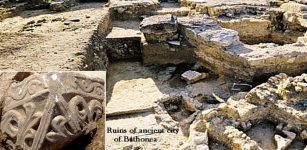 Excavations In Ancient City Of Bathonea Reveal Traces Of Viking Settlement
Archaeology | Aug 27, 2020
Excavations In Ancient City Of Bathonea Reveal Traces Of Viking Settlement
Archaeology | Aug 27, 2020 -
 How Did A Piece Of An ‘Epic’ Viking Sword End Up In The Netherlands?
Vikings | Dec 4, 2024
How Did A Piece Of An ‘Epic’ Viking Sword End Up In The Netherlands?
Vikings | Dec 4, 2024 -
 Time Capsule: Sunken Ancient City Of Baiae
Archaeology | Mar 27, 2014
Time Capsule: Sunken Ancient City Of Baiae
Archaeology | Mar 27, 2014 -
 Strange And Unexplained Events In Transylvania – One Of The Most Mysterious Places In Europe
Featured Stories | Jan 6, 2022
Strange And Unexplained Events In Transylvania – One Of The Most Mysterious Places In Europe
Featured Stories | Jan 6, 2022

